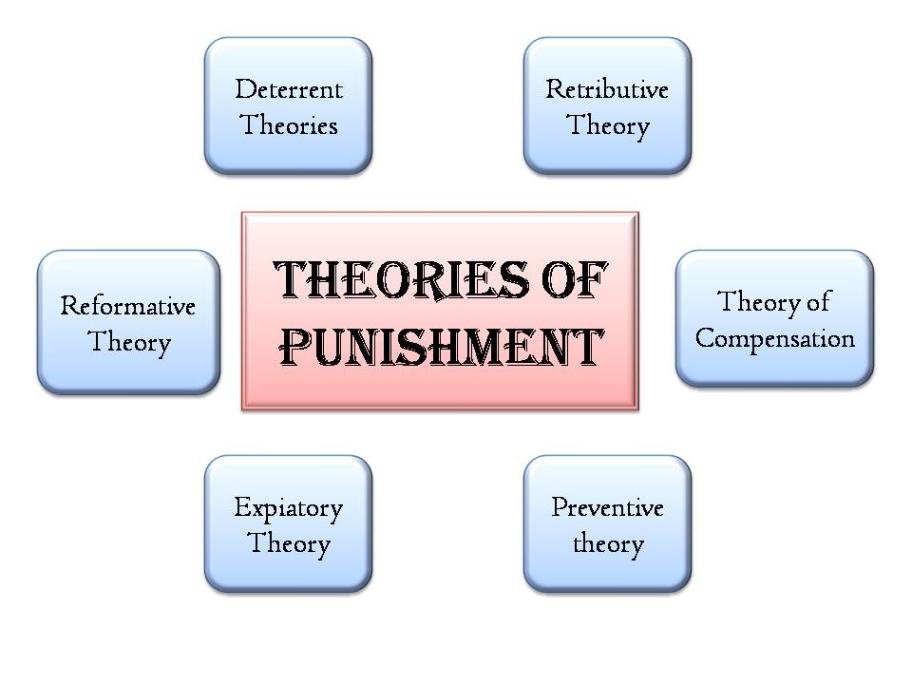Introduction to the various Punishment theories: The penalty is the personal or property suffering that society causes to the offenders or guilty of the law.
Section 53 of IPC
According to Section 53, the offenders are liable for the punishment following the provisions of this Code;
death
Life imprisonment
Imprisonment has two descriptions (Section 53 of the Indian Penal Code), namely, Rigorous, that is with hard labor & Simple imprisonment
Forfeiture of property
Fine
Can protect society by preventing potential offenders from committing more crimes and transforming them into law-abiding citizens.
The previous section did not give a definition and only listed various penalties.
Theories of punishment

Deterrent Theories
This theory is based on severe punishment. This argument says that the penalty is intended to prevent in future the perpetrator of a crime and to give an example to the other perpetrators of a criminal who will conduct a crime, too.
Severe punishments and public executions have also been carried out in former times with the main aim of deterring others and giving an example to punish a violation of the law. The principle of deterrent has two-fold effects.
Firstly, the offender avoids committing the crime in the future, and secondly, the person in the society who has a criminal tendency in his mind and who can commit the crime in the future learns from the deterrent punishment.
Criticism
The above punishment idea has practically failed to achieve its aim because crimes are often done under the heat of passion or high excitement and provocation when the offender loses his mental balance by applying his mind to the consequences.
In these cases, punishment hardly works as a deterrent, secondly, when the offender is punished, the punishment to a certain extent loses its rigor for him &once an offender undergoes imprisonment, he is no longer afraid of it to the same degree as he was before he served his first term.
Retributive Theory
The punishment was largely punishing in primitive societies and the wrongdoer might seek revenge against the perpetrator. “Eye for an eye” was the principal. The principle has been accepted and respected for many years.
In the principle of retributive theory, the criminal must meet his comparable pain and equivalent suffering and separate from the gain of society. Kant, Aristotle, Stephen, and Holmes supported this view.
The origins of the doctrine of retributive are the basic vindication of the wrongdoer. The above theory is based on the idiom “tit for tat”. Kant and Hegel are the proponents of this idea.
Criticism
The retributive theory ignores the causes. Furthermore, this theory ignores the reality that two wrongs do not necessarily equal a good ethical attitude to an offence, which is the major foundation of the retributive theory, which is slowly losing ground in modern times.
Reformative Theory
This theory holds that punishment must exist to reform the offender. Criminals do not end up being human when they commit a crime. He has committed a crime/crime that will never happen again.
Thus, the main aim of punishment under the reformative theory is to bring about moral improvement in the offender. This theory is also known as the remedial or rehabilitative theory. Certain Directions have been prescribed under this Thesis.
When sentencing, the judge must consider the characteristics and age of the offender, his fertility, the circumstances in which he committed the crime, and the purpose for which he committed the crime.
The purpose of the above exercise is to enlighten the judge to understand the exact nature of the situation to give the appropriate sanction to these circumstances.
The proponents of this theory say that a radical improvement in character can be brought about by practical, sympathetic, and loving treatment of wrongdoers. However, critics say that remedial theory alone is not enough; to be successful there must be a mix of preventive theory and corrective theory. Critics believe that in the event of a deadlock between the two principles, the deterrent principle should prevail.
Criticism
In some cases, the reformative viewpoint is of dubious utility. First of all, people are those who are invincible evil. Crime is a habit for them, and they are beyond the reach of any reform program. Second, if offenders are kept in prisons in comfortable conditions, the prisons may become a home for the poor and unemployed.
Expiatory Theory
This principle is also known as the principle of penance. According to this principle, punishment is a necessary condition for the purification of offenders. The penalty for a crime is the debt owed by the criminal to the victim. After being sentenced, the debt has been paid, the responsibility is eliminated, and the guilt is replaced by innocence. Hegel supports the above-mentioned theory of punishment.
Criticism
It is very difficult to work out this theory successfully in so far as it is difficult to ascertain an equivalent of guilt in terms of suffering. It is impossible to weigh the guilt on that fine-scale of suffering also the effect of the same punishment may vary upon two different accused.
Preventive theory
This philosophy of punishment is linked to Bach’s name, which says preventing is better than cure. The purpose of this penalty is to prohibit or prevent the offender from repeating the offence.
The major objective is to weaken the offender by repeating the crime by disabling its physical power to perpetrate a crime. Bentham, homies is supportive of this theory.
Criticism
Prevention as a punishment objective is not very persuasive and does not function well to monitor crime. The crime seldom is repeated by someone who commits a crime under significant psychological stress. It would be useless to penalize a person who commits a crime under such pressure.
Theory of Compensation
The theory maintains that the victims who have suffered at the hands of the perpetrator should also be punished. Critics, however, contend that the idea does not control the crime rate.
This is because it is always an economic objective to commit a crime. According to this theory, the reimbursement would also be made to the people who have been the victims of the government’s misdeeds.
Conclusion
We examined some theories on punishment above. While each one of them has its own merit, none is accepted by the penologist generally. We must thus investigate the crime before prescribing an appropriate kind of punishment according to the physical, social, educational, and cultural background of the perpetrator.

























